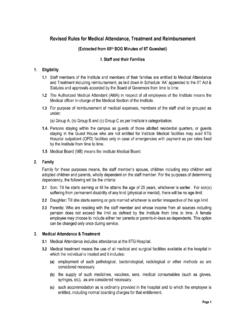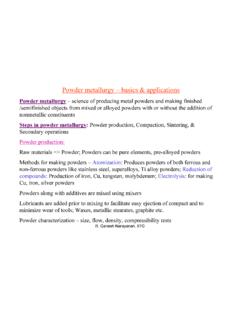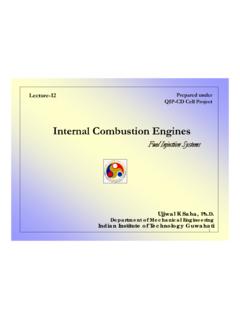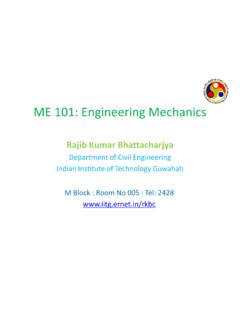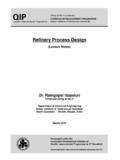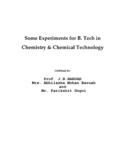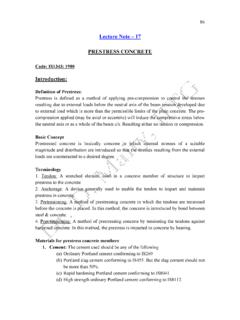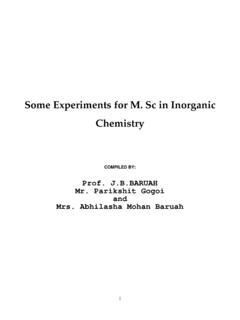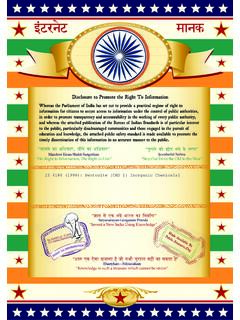Transcription of Metal casting processes - IIT Guwahati
1 Narayanan, IITG ME 222 Manufacturing Technology - I (3-0-0-6) Introduction to manufacturing processes casting processes : Moulding materials and their requirements; Patterns: Types and various pattern materials. Various casting methods, viz., sand casting investment casting , pressure die casting , centrifugal casting , continuous casting , thin roll casting ; Mould design; casting defects and their remedies. (14 classes) Metal forming processes : Various Metal forming techniques and their analysis, viz., forging, rolling, extrusion, wire drawing, sheet Metal working, spinning, swaging, thread rolling; Super plastic deformation; Metal forming defects.
2 (14 classes) Metal joining processes : brazing, soldering, welding; Solid state welding methods; resistance welding; arc welding; submerged arc welding; inert gas welding; Welding defects, inspection. (9 classes) Powder metallurgy & its applications (3 classes) Narayanan, IITG Texts: 1. A Ghosh and A K Mallik, Manufacturing Science, Wiley Eastern, 1986. 2. P Rao, Manufacturing Technology: Foundry, Forming And Welding, Tata McGraw Hill, 2008. 3. Groover, Introduction to manufacturing processes , John Wiley & Sons, 2012 4. Prashant P Date, Introduction to manufacturing technologies Principles and technologies, Jaico publications, 2010 (new book) References: 1.
3 J S Campbell, Principles Of Manufacturing Materials And processes , Tata McGraw Hill, 1995. 2. P C Pandey and C K Singh, Production Engineering Sciences, Standard Publishers Ltd., 2003. 3. S Kalpakjian and S R Schmid, Manufacturing processes for Engineering Materials, Pearson education, 2009. 4. E. Paul Degarmo, J T Black, Ronald A Kohser, Materials and processes in manufacturing, John wiley and sons, 8th edition, 1999 Tentative grading pattern: QUIZ 1: 10; QUIZ 2: 15; MID SEM: 30; END SEM: 45; ASSIGNMENT: 10 Narayanan, IITG Metal casting processes casting is one of the oldest manufacturing process.
4 It is the first step in making most of the products. Steps: - Making mould cavity - Material is first liquefied by properly heating it in a suitable furnace. - Liquid is poured into a prepared mould cavity - allowed to solidify - product is taken out of the mould cavity, trimmed and made to shape We should concentrate on the following for successful casting operation: (i) preparation of moulds of patterns (ii)Melting and pouring of the liquefied Metal (iii)Solidification and further cooling to room temperature (iv)Defects and inspection Narayanan, IITG Advantages Molten material can flow into very small sections so that intricate shapes can be made by this process.
5 As a result, many other operations, such as machining, forging, and welding, can be minimized. Possible to cast practically any material: ferrous or non-ferrous. The necessary tools required for casting moulds are very simple and inexpensive. As a result, for production of a small lot, it is the ideal process. There are certain parts (like turbine blades) made from metals and alloys that can only be processed this way. Turbine blades: Fully casting + last machining. Size and weight of the product is not a limitation for the casting process. NPTEL course on Manufacturing processes I, Pradeep Kumar et al.
6 Narayanan, IITG Limitations Dimensional accuracy and surface finish of the castings made by sand casting processes are a limitation to this technique. Many new casting processes have been developed which can take into consideration the aspects of dimensional accuracy and surface finish. Some of these processes are die casting process, investment casting process, vacuum-sealed moulding process, and shell moulding process. Metal casting is a labour intensive process Automation: a question NPTEL course on Manufacturing processes I, Pradeep Kumar et al.
7 Narayanan, IITG Typical sand mould NPTEL course on Manufacturing processes I, Pradeep Kumar et al. Mould Section and casting nomenclature pattern attached with gating and risering system Narayanan, IITG Mould Section and casting nomenclature, (a) top view, (b) front view J S Campbell, Principles Of Manufacturing Materials And processes Narayanan, IITG Flask: A Metal or wood frame, without fixed top or bottom, in which the mould is formed. Depending upon the position of the flask in the moulding structure, it is referred to by various names such as drag lower moulding flask, cope upper moulding flask, cheek intermediate moulding flask used in three piece moulding.
8 Pattern: It is the replica of the final object to be made. The mould cavity is made with the help of pattern. Parting line: This is the dividing line between the two moulding flasks that makes up the mould. Moulding sand : sand , which binds strongly without losing its permeability to air or gases. It is a mixture of silica sand , clay, and moisture in appropriate proportions. Facing sand : The small amount of carbonaceous material sprinkled on the inner surface of the mould cavity to give a better surface finish to the castings. Important casting terms NPTEL course on Manufacturing processes I, Pradeep Kumar et al.
9 J S Campbell, Principles Of Manufacturing Materials And processes Narayanan, IITG Core: A separate part of the mould, made of sand and generally baked, which is used to create openings and various shaped cavities in the castings. Pouring basin: A small funnel shaped cavity at the top of the mould into which the molten Metal is poured. Sprue: The passage through which the molten Metal , from the pouring basin, reaches the mould cavity. In many cases it controls the flow of Metal into the mould. Runner: The channel through which the molten Metal is carried from the sprue to the gate.
10 Gate: A channel through which the molten Metal enters the mould cavity. Chaplets: Chaplets are used to support the cores inside the mould cavity to take care of its own weight and overcome the metallostatic force. Riser: A column of molten Metal placed in the mould to feed the castings as it shrinks and solidifies. Also known as feed head . Vent: Small opening in the mould to facilitate escape of air and gases. Narayanan, IITG The six basic steps in making sand castings are, (i) Pattern making, (ii) Core making, (iii) Moulding, (iv) Melting and pouring, (v) Cleaning Pattern making - Pattern: Replica of the part to be cast and is used to prepare the mould cavity.

